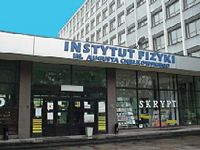ZFT
Z Skrypty dla studentów Ekonofizyki UPGOW
(Różnice między wersjami)
| (Nie pokazano 4 wersji pomiędzy niniejszymi.) | |||
| Linia 1: | Linia 1: | ||
{{Languages}} | {{Languages}} | ||
| + | [[Image:FIZYKA.jpg|200px|thumb|right|Institute of Physics]] | ||
| Linia 19: | Linia 20: | ||
The Department of Theoretical Physics was founded in the early '70 and has now 14 permanent staff members and 7 PhD students. | The Department of Theoretical Physics was founded in the early '70 and has now 14 permanent staff members and 7 PhD students. | ||
| - | + | ||
| + | The founder and for a long time head of department was the late Prof. Andrzej Pawlikowski. The current head of the department is Prof. Jerzy Łuczka - member of Liaison Scientists Network. | ||
Research area: | Research area: | ||
| - | + | * theoretical condensed matter physics (strongly correlated electron systems, superconductivity, mesoscopic systems, coexistence of magnetism and superconductivity) | |
| - | + | * statistical physics (nonequilibrium effects, stochastic processes, fluctuation - induced transport) | |
| - | + | * computational physics (Monte Carlo methods, simulation of random processes, genetic algorithms and parallel computing) | |
| - | + | * nanophysics (electric and magnetic properties of carbon nanotubes and nanowires, transport in nanosystems) | |
| - | + | * physics of phase transitions (scaling and critical relations, chemical potential induced phase transitions, quantum critical points) | |
| - | + | * biophysics (intercell transport, biological motors) | |
| - | + | * quantum computation (entanglement of meso- and nanosystems, open quantum systems, models for an experimental realizations of qubits, qubits based on the quantum rings, quantum information processing) | |
| - | + | * medical physics(influence of electromagnetic radiation on the live organism, simulation of blood flow dynamics) | |
International Cooperation: | International Cooperation: | ||
| - | + | * University: Augsburg, Barcelona, Bradford, Camerino, Duisburg, Humboldta w Berlinie, Leuven, Regensburg | |
| - | + | * International Center for Condensed Matter Physics, Brazil | |
| - | + | * Joint Institute for Nuclear Research, Dubna | |
National Cooperation: | National Cooperation: | ||
| - | + | * Maria Curie - Sklodowska University in Lublin, Jagiellonian University in Krakow, Institute of Molecular Physics Polish Academy of Science in Poznan, Foundation for the Development of Cardio - Surgery in Zabrze | |
Participation in scientific programs: | Participation in scientific programs: | ||
| - | + | * European Science Foundation: "Stochastic Dynamics: Fundamentals and Applications" | |
| - | + | * Polish research network: "Laboratory of Physical Foundation of Information Processing" | |
| - | + | * The Polish-British Co-operation program: "Influence of entangled photons on the properties of mesoscopic systems" | |
| - | + | * The German-Polish Co-operation program MNiSW-DAAD: "Dissipative transport and ordering in complex systems" | |
Aktualna wersja na dzień 19:19, 13 paź 2009
| Language: |
English |
University of Silesia
Institute of Physics
Department of Theoretical Physics tel./fax +48 32 258-36-53 Secretary: +48 32 359-14-09 Room: 363, Bankowa 14
Corresponding address: Institute of Physics University of Silesia 40-007 Katowice, Poland
The Department of Theoretical Physics was founded in the early '70 and has now 14 permanent staff members and 7 PhD students.
The founder and for a long time head of department was the late Prof. Andrzej Pawlikowski. The current head of the department is Prof. Jerzy Łuczka - member of Liaison Scientists Network.
Research area:
- theoretical condensed matter physics (strongly correlated electron systems, superconductivity, mesoscopic systems, coexistence of magnetism and superconductivity)
- statistical physics (nonequilibrium effects, stochastic processes, fluctuation - induced transport)
- computational physics (Monte Carlo methods, simulation of random processes, genetic algorithms and parallel computing)
- nanophysics (electric and magnetic properties of carbon nanotubes and nanowires, transport in nanosystems)
- physics of phase transitions (scaling and critical relations, chemical potential induced phase transitions, quantum critical points)
- biophysics (intercell transport, biological motors)
- quantum computation (entanglement of meso- and nanosystems, open quantum systems, models for an experimental realizations of qubits, qubits based on the quantum rings, quantum information processing)
- medical physics(influence of electromagnetic radiation on the live organism, simulation of blood flow dynamics)
International Cooperation:
- University: Augsburg, Barcelona, Bradford, Camerino, Duisburg, Humboldta w Berlinie, Leuven, Regensburg
- International Center for Condensed Matter Physics, Brazil
- Joint Institute for Nuclear Research, Dubna
National Cooperation:
- Maria Curie - Sklodowska University in Lublin, Jagiellonian University in Krakow, Institute of Molecular Physics Polish Academy of Science in Poznan, Foundation for the Development of Cardio - Surgery in Zabrze
Participation in scientific programs:
- European Science Foundation: "Stochastic Dynamics: Fundamentals and Applications"
- Polish research network: "Laboratory of Physical Foundation of Information Processing"
- The Polish-British Co-operation program: "Influence of entangled photons on the properties of mesoscopic systems"
- The German-Polish Co-operation program MNiSW-DAAD: "Dissipative transport and ordering in complex systems"
